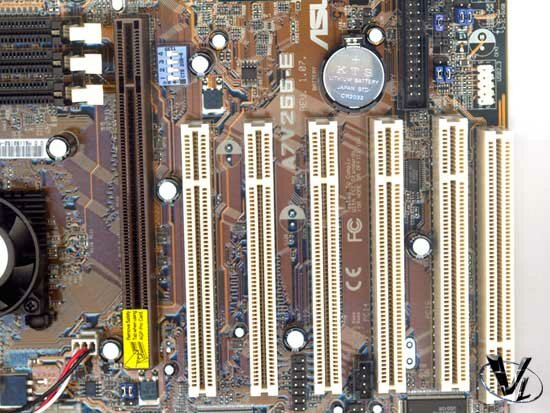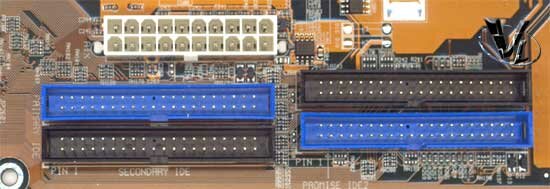|
Written By:
Date Posted: April 1, 2002
The Board
The A7V266-E is neatly laid out. It's not unusually big, measuring 9.6" x 12.0", and shouldn't have any problems fitting into any ATX compliant case. Like all new AMD motherboards, the A7V266-E is a socket based board, supporting DDR ram exclusively.

One thing you may notice about the socket is that there isn't any thermal sensor we're normally accustomed to. We'll look into this more later. Another added bonus, at least for those of you who are clumsy with heatsink installations, is that there's a protective tape on either side of the socket. This will reduce the chances of you splitting a trace if you accidentally slip with the screwdriver while installing a heatsink. Unfortunently, Asus only seemed to go halfway on this, since the strip of protective tape isn't very large. Another note for those of you who use the large heatsinks that bolt directly into the mainboard; the four surrounding holes are grounded.

The (blurry) pic above are the jumpers for the CPU. Our default was 1-2, which will enable support for Palominos, or Athlon XPs, whereas 2-3 is for standard Durons and Athlons. The jumper below it, labeled "ThemCPU" is for thermal sensor capability. It's not stated what "reserved" is for, but initially, our Athlon XP 2000+ was reporting temperatures of 68C, which is way to high. Switching to "reserved" lowered temperatures by over 20C. Just a FYI: The A7V266-E does not make use of the internal diode present in Athlon XPs. It uses the older method of integrating the thermal monitoring in the socket itself. Although not as effective as using the built-in Athlon XP diode, it does report more accurate temperature readings than a simple probe.

The A7V266-E includes an AGP Pro slot. There's a plastic tab that'll prevent users from improperly seating their regular AGP cards. Though this won't really matter for the majority of users, CAD and workstation types can plug in your fancy OpenGL cards here.

There are 5 PCI slots available, in addition to the AGP Pro, as well as an ACR slot. Being so used to Abit boards and their 6 PCI slots, I'll admit I was a little disappointed there is one less here, but I doubt this will be a concern for most people. The ACR slot is useless though, and I imagine it will go unused for most of you.

You have the standard IDE connections and the added RAID connections near the edge of the board. I've always preferred the placement of the ATX connection near the edge, away from the socket, which is what Asus does here. This will keep the, typically thick, ATX power connection away from your heatsink. I was a little perplexed on why the RAID connections were located higher than the standard IDE, since for anyone who chooses to use the RAID, your hard drives will likely be near the bottom of the case.

The RAID capabilities are provided by the Promise RAID "Lite" controller. Since most RAID controllers can add from 80$ to 150$ to the cost of the system, having it integrated into the board can save a buyer a few bucks if you're a RAID junkie like me.
According to documentation, it supports RAID 0, and RAID 1. To explain, RAID stands for Redundant Array of Independent (or Inexpensive, depending who you ask) Disks. Back in the past, RAID was popular only with servers and workstations that supported SCSI disks. Hardly inexpensive, these disks were the only ones that were capable of working in a RAID array. Times have changed, and RAID has become very popular in the retail market.
RAID 0, also known as "Striping" configures several drives, a minimum of 2, so that data is written at the same time on all the drives in the array. Since data, ones and zeros, is written between the drives, where ones go to one drive, zeros to the other, your performance improves. When one disk fails, the entire array is lost. This may sound risky, but the same would happen if you relied on one drive. Just keep your backups current, and you'll be fine. For optimal performance, it's generally recommended you use identical drives. The reason is because all drives will perform only as fast as it's slowest member. Another reason for identical drives, is that RAID 0 will use the full capacity of it's smallest drive. So, if you combine a 40GB drive with a 20GB drive, your array total will only be 40GB, rather than 60GB.
RAID 1, known as "Mirroring", is exactly that. It'll take 2 drives, and "mirror" them, writing the same data on both drives. This is the slowest method of RAID, but it provides full redundancy in case of failure.
If RAID isn't important to you, then you can simply use the Promise connections as extra IDE connections.
Previous Page - The KT266A
Next Page - More Goodness
|


